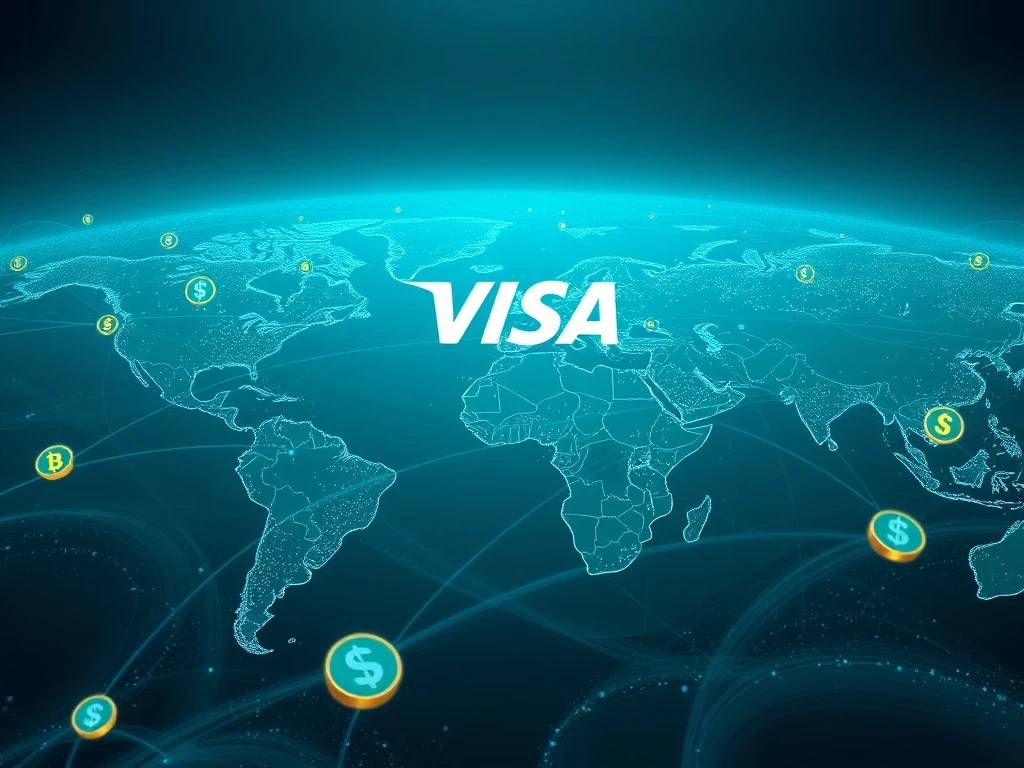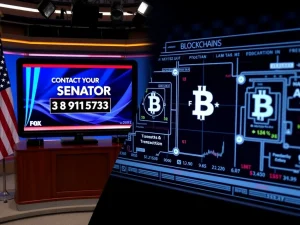Transformative Visa Stablecoin Strategy: Powering $225M Cross-Border Payments & Future Growth

Are you ready for a financial revolution? The world of payments is undergoing a seismic shift, and global giants like Visa are leading the charge. For anyone interested in the future of money and blockchain technology, Visa’s bold move into leveraging Visa stablecoins for cross-border transactions is not just news—it’s a blueprint for the next era of global commerce.
The Unstoppable Rise of Stablecoins in Global Payments
Visa’s strategic pivot towards stablecoins is fundamentally reshaping how money moves across borders, especially in emerging markets. Cuy Sheffield, Visa’s head of crypto, has clearly articulated that stablecoins aren’t aiming to disrupt traditional U.S. retail transactions. Instead, their true power lies in revolutionizing cross-border payments in regions where access to dollar-denominated transactions is limited. This targeted approach highlights a keen understanding of market needs and the unique value proposition of digital assets.
By 2025, the stablecoin market is projected to reach an astounding $250 billion. Visa is already at the forefront of this growth, having processed a significant $225 million in stablecoin volume through its innovative Visa Tokenized Asset Platform (VTAP). This platform isn’t just a concept; it’s a fully operational system enabling 24/7/365 settlements and supporting multiple blockchain networks. This commitment to robust infrastructure underscores Visa’s long-term vision for integrating digital currencies into its core offerings.
Why Stablecoins? Unlocking Efficiency and Access
The appeal of stablecoins for cross-border transactions is multifaceted. They offer:
Speed: Traditional international transfers can take days. Stablecoins settle in minutes or even seconds.
Cost-Effectiveness: Lower transaction fees compared to traditional correspondent banking systems, which often involve multiple intermediaries.
Accessibility: Bridging gaps in financial inclusion, especially in regions with underdeveloped banking infrastructure.
Transparency: Blockchain’s inherent immutability provides a clear, auditable trail for every transaction.
Visa’s approach isn’t about replacing existing systems but enhancing them. By integrating stablecoins into their current infrastructure, they are creating a hybrid model that combines the familiarity and security of traditional payments with the efficiency and innovation of blockchain technology. This strategy minimizes disruption while maximizing benefits.
Strategic Alliances Fueling Blockchain Innovation
Visa isn’t navigating this new landscape alone. The company has forged crucial alliances with key players in the crypto and traditional finance sectors. Collaborations with fintech firms like Stripe and Baanx in Africa and Latin America are accelerating stablecoin adoption on the ground, making transactions faster and more accessible for everyday users and businesses.
Furthermore, strategic partnerships with institutions such as Anchorage, BBVA, and Circle are enabling real-time settlements and expanding access in developing economies. These collaborations are vital for building trust and ensuring the seamless flow of digital finance across diverse markets. The synergy between established financial giants and innovative crypto companies is a powerful catalyst for change.
Regulatory Clarity: A Game Changer for the Stablecoin Market
The growth of the stablecoin market is also being significantly bolstered by increasing regulatory clarity. Frameworks like the U.S. GENIUS Act of 2025 and the EU’s MiCA framework are providing much-needed certainty, boosting institutional confidence in stablecoin use cases. This regulatory support is crucial for mainstream adoption, as it provides a legal and operational foundation for businesses and financial institutions to engage with digital assets without undue risk.
Visa’s robust financial health, demonstrated by $18.69 billion in free cash flow and a 65.68% operating margin in FY 2024, provides a strong foundation for its continued innovation in tokenization initiatives. These initiatives are not just about future-proofing; they are already generating tangible results, contributing an estimated $40 billion in incremental e-commerce revenue and reducing fraud-related losses by $650 million.
Emerging Markets: The Epicenter of Stablecoin Adoption
Emerging markets are central to Visa’s vision. Here, stablecoins address critical gaps in correspondent banking systems, offering a viable and often superior alternative for remittances and B2B transactions. These regions often suffer from high fees, slow processing times, and limited access to traditional financial services, making stablecoins a compelling solution.
By Q1 2025, stablecoin-based remittances had already captured 3% of the colossal $200 trillion global cross-border market. This share is expected to grow substantially as blockchain infrastructure matures and more users become comfortable with digital currencies. Visa’s hybrid models, such as stablecoin-linked Visa cards in partnership with Bridge and Yellow Card, exemplify this integration. These cards allow users to convert stablecoins into fiat currency for everyday purchases, seamlessly blending the benefits of digital assets with familiar payment methods.
What Does This Mean for the Future of Payments?
Visa’s forward-looking strategy anticipates significant shifts in the financial landscape. By 2025, the company projects that financial institutions must adopt stablecoin strategies to remain competitive. Their expansion into tokenized deposits, real-time settlements, and AI-driven fraud detection aims to sustain leadership amidst challenges like decentralized finance (DeFi) and potential regulatory adjustments.
Despite inherent risks in any rapidly evolving technology, investors view Visa’s dual focus—integrating stablecoins while maintaining dominance in legacy systems—as a key differentiator. This balanced approach is expected to improve earnings visibility by FY 2028, positioning Visa as a resilient and adaptable leader in the global payments ecosystem. The integration of stablecoins has already demonstrated tangible benefits, particularly in high-value cross-border transactions where they offer clear speed and cost advantages over traditional systems.
Visa’s emphasis on partnerships and regulatory alignment underscores its commitment to fostering an efficient and inclusive financial ecosystem. As blockchain technology continues to evolve, the company’s ability to co-opt disruptive innovations rather than resist them positions it perfectly to capitalize on the next wave of global payment solutions. This proactive stance ensures that Visa remains not just relevant, but a driving force in the future of money.
Frequently Asked Questions (FAQs)
What are stablecoins and why is Visa interested in them?
Stablecoins are cryptocurrencies designed to maintain a stable value, typically pegged to a fiat currency like the U.S. dollar. Visa is interested in them because they offer a fast, cost-effective, and efficient way to conduct cross-border payments, especially in emerging markets where traditional banking infrastructure can be slow or limited. They provide a digital alternative to traditional money transfers.
How is Visa leveraging stablecoins for cross-border payments?
Visa uses its Visa Tokenized Asset Platform (VTAP) to process stablecoin transactions. This platform enables 24/7/365 settlements across multiple blockchain networks. They also partner with fintech companies and financial institutions to facilitate stablecoin-based remittances and B2B transactions, integrating digital assets into their existing payment rails.
What is the Visa Tokenized Asset Platform (VTAP)?
VTAP is Visa’s proprietary platform designed to facilitate the secure and efficient transfer of tokenized assets, including stablecoins. It acts as a bridge between various blockchain networks and Visa’s traditional payment infrastructure, enabling seamless, real-time settlements for digital currency transactions.
What role do partnerships play in Visa’s stablecoin strategy?
Partnerships are crucial. Visa collaborates with fintechs (like Stripe, Baanx), crypto companies (like Circle), and traditional financial institutions (like Anchorage, BBVA) to accelerate stablecoin adoption, expand access, and ensure regulatory compliance. These alliances help integrate stablecoins into diverse payment ecosystems and reach new user bases.
How will stablecoins impact traditional payment systems?
Visa’s strategy is not to disrupt but to enhance. Stablecoins are being integrated into existing systems to offer a hybrid model that combines the best of both worlds. They will primarily impact high-value, cross-border transactions by offering speed and cost advantages, potentially reducing reliance on traditional correspondent banking for certain use cases, but coexisting with fiat payments for broader retail use.
What is the projected growth of the stablecoin market?
The stablecoin market is experiencing rapid growth. The article indicates that the market had grown to $250 billion by 2025. This expansion is driven by increasing institutional adoption, regulatory clarity, and the clear benefits stablecoins offer for efficient digital transactions.









